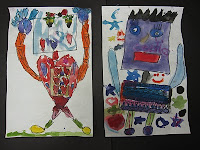


Fifth Grade students created simplified animals and filled them with geometric designs inspired by the Senufo people of the Ivory Coast in Africa. These types of paintings are usually painted on cloth. At one time, the Senufo people believed these cloth paintings would bring them good luck if they wore the cloth while hunting. Today, the cloth is mainly made to sell to tourists.






















